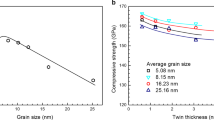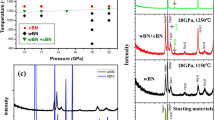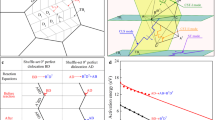Abstract
Arising from Y. Tian et al. Nature 493, 385–388 (2013)10.1038/nature11728
Tian et al.1 report synthesis of “nanotwinned” cubic boron nitride (“nt-cBN”). These authors claim that its unprecedented Vickers hardness of 108 GPa is due to nanotwinning, and that hardening of cBN is continuous with decreasing twin thickness down to the smallest size investigated, in contrast to the expected reverse Hall–Petch effect. We demonstrate here that it has been known for tens of years that “nt-cBN” (refs 2–4) hardens owing to a complex of phenomena associated with its microstructure and defects; we also consider that Tian et al.1 provide no proof that the hardness of “nt-cBN” is larger than 85 GPa, which is the previously reported maximum for nanostructured boron nitride2,4. Thus the claim of continuous hardening down to a few nanometres twin thickness is, in our opinion, unjustified. There is a Reply to this Brief Communication Arising by Tian, Y. et al. Nature 502, http://dx.doi.org/10.1038/nature12621 (2013).
This is a preview of subscription content, access via your institution
Access options
Subscribe to this journal
Receive 51 print issues and online access
$199.00 per year
only $3.90 per issue
Buy this article
- Purchase on Springer Link
- Instant access to full article PDF
Prices may be subject to local taxes which are calculated during checkout


Similar content being viewed by others
References
Tian, Y. et al. Ultrahard nanotwinned cubic boron nitride. Nature 493, 385–388 (2013)
Corrigan, F. R. & Bundy, F. P. Direct transitions among the allotropic forms of boron nitride at high pressures and temperatures. J. Chem. Phys. 63, 3812–3820 (1975)
Horiuchi, S., He, L.-L., Huang, J., Taniguchi, T. & Akaishi, M. Development of super-hard materials using HRTEM. J. Surf. Anal. 3, 197–202 (1997)
Dubrovinskaia, N. et al. Superhard nanocomposite of dense polymorphs of boron nitride: noncarbon material has reached diamond hardness. Appl. Phys. Lett. 90, 101912 (2007)
Solozhenko, V. L., Kurakevych, O. O. & Le Godec, Y. Creation of nanostructures by extreme conditions: high-pressure synthesis of ultrahard nanocrystalline cubic boron nitride. Adv. Mater. 24, 1540–1544 (2012)
Rao, W.-F. & Wang Diffraction theory of nanotwin superlattices with low symmetry phase: adaptive diffraction of imperfect nanotwin superlattices. Phil. Mag. 90, 197–217 (2010)
Bersani, D., Lott, P. P. & Ding, X.-Z. Phonon confinement effects in the Raman scattering by TiO2 nanocrystals. Appl. Phys. Lett. 72, 73–75 (1998)
Wells, A. F. Structural Inorganic Chemistry (Oxford Univ. Press, 1975)
Dubrovinskaia, N. & Dubrovinsky, L. in High-Pressure Crystallography: From Fundamental Phenomena to Technological Applications (eds Boldyreva, E. & Dera, P. ) 419–434 (Springer Science and Business Media, 2010)
Brazhkin, V. et al. What does ‘harder than diamond’ mean? Nature Mater. 3, 576–577 (2004)
Eremets, M. I. et al. The strength of diamond. Appl. Phys. Lett. 87, 141902 (2005)
Dubrovinsky, L., Dubrovinskaia, N., Prakapenka, V. B. & Abakumov, A. M. Implementation of micro-ball nanodiamond anvils for high-pressure studies above 6 Mbar.Nature Commun 3, 1163 (2012)
Sumiya, H. & Irifune, T. Indentation hardness of nano-polycrystalline diamond prepared from graphite by direct conversion. Diamond Relat. Mater. 13, 1771–1776 (2004)
Sumiya, H. Super-hard diamond indenter prepared from high purity synthetic diamond crystal. Rev. Sci. Instrum. 76, 026112 (2005)
Author information
Authors and Affiliations
Contributions
N.D. and L.D. contributed equally to this paper.
Corresponding author
Ethics declarations
Competing interests
Declared none.
PowerPoint slides
Rights and permissions
About this article
Cite this article
Dubrovinskaia, N., Dubrovinsky, L. Controversy about ultrahard nanotwinned cBN. Nature 502, E1–E2 (2013). https://doi.org/10.1038/nature12620
Received:
Accepted:
Published:
Issue Date:
DOI: https://doi.org/10.1038/nature12620
This article is cited by
-
Elastic and mechanical softening in boron-doped diamond
Scientific Reports (2017)
-
Large indentation strain-stiffening in nanotwinned cubic boron nitride
Nature Communications (2014)
-
Tian et al. reply
Nature (2013)
Comments
By submitting a comment you agree to abide by our Terms and Community Guidelines. If you find something abusive or that does not comply with our terms or guidelines please flag it as inappropriate.



